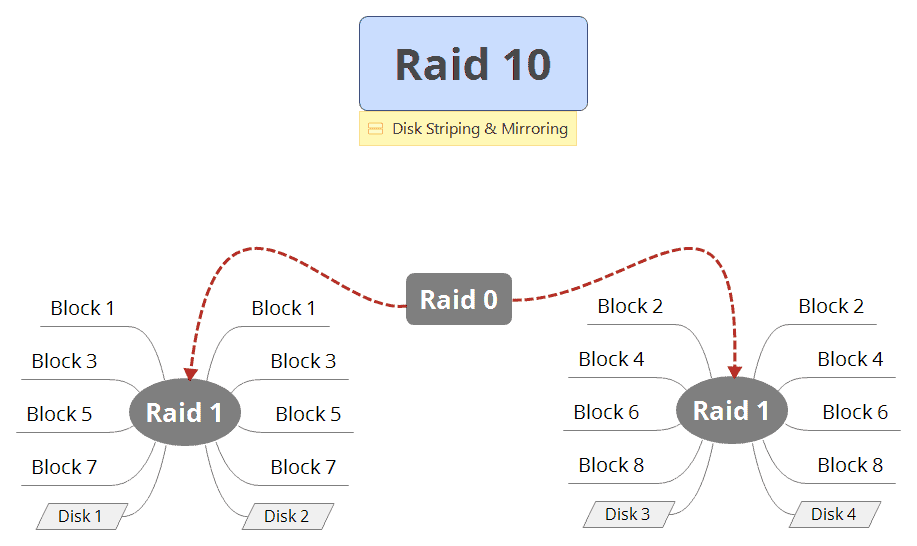What exactly is RAID, and why do you need it? And why are the various RAID levels? RAID, short for Redundant Array of Independent Disks, is a data storage virtualization technology that combines multiple physical drive components into a single logical unit for the purposes of data redundancy, performance improvement, or both. This is because a RAID system distributes and replicates data across multiple drives, thereby providing fault tolerance in the event of a drive failure.
The various RAID levels refer to different ways in which data is distributed and replicated across drives.
RAID 0, 1, 10, and 5 are all common types of RAID that are used in Windows environments. If you are using a Windows server, you should consider using RAID to improve performance and protect your data.
RAID 0
RAID 0 is the simplest type of RAID, and it stripes data across multiple drives to improve performance.
With RAID 0, data is split evenly across all disks in the array, which allows for faster read and write speeds. However, because RAID 0 does not provide redundancy, all data in the array is lost if one disk fails.

RAID 0 Usage:
Choose a RAID configuration that allows to read or write data at high speed as the data spreads over multiple disks (striped disks). Since RAID 0 does not accept faults, this is a must-use for non-critical data. RAID0 provides storage with a total of 256MB. The performance of RAID arrays is significantly increased. You send different portions of a CPU to four different processors instead of writing sequential instructions to the same CPU, so you receive four times as fast. You can use all the combined storage on the system, and 2x 1TB will be displayed on 2x1TB drives.
RAID 1
RAID 1 mirrors data across multiple drives. This provides redundancy in case of a drive failure, so you have two drives with the same data. This type of RAID is typically used for data that is not time-sensitive, such as video or music files.

RAID 1 Usage:
While it is possible to configure the RAID 1 solution by using specialized software and hardware, it can be a common method for creating a RAID 1 system. Because that’s the only storage available on one drive, two 1 TB drives mirror each other, giving only 1 TB total storage. Unlike RAID0, RAID1 is protected against redundancies. So if your drive goes missing it will be available to you as if it were yours, it allows you to restore a defective drive with little downtime. RAID1 can help store information such as bank and credit card information or personal data.
RAID 10
RAID 10, also known as RAID 1+0, combines mirroring and striping. This provides both redundancy and performance improvements. If one of the drives in the array fails, the data will be available on another drive. This is called “fault tolerance”.

RAID 10 Usage:
The AID 10 name is not coincident. 10. Unlike RAID 6, these drives use four drives and have an integrated RAID-1 mirroring and a RAID 0 striping feature that provides speed and redundantness. If your RAID 10 configuration includes 4 hard drives, two mirror drives hold 80%, and the rest reflects 80%. Although you will be using half your drive storage, RAID 10 can be combined for optimum reliability and performance. Both hardware and software can implement RAID 10. In general, hardware RAID is faster than software RAID when it comes to RAID 10 implementation, but both can get the job done. Software RAID may be a better option for some users because it is typically more affordable than hardware RAID.
RAID 5
RAID 5 stripes data and parity information across three or more disks, allowing for better performance and fault tolerance. It uses striping parity to provide protection against disk failures. The data is divided into blocks, and each block is written to a different disk. parity is a mathematical calculation that is used to reconstruct data if one of the disks fails.

RAID 5 Usage:
RAID 5 is a recommended configuration for systems that require a balance of performance and fault tolerance. Striping provides the speed, mirroring offers the fault tolerance, and parity provides both. A RAID 5 volume can sustain one disk failure without losing any data. If you are using a Windows server, you should consider using RAID to improve performance and protect your data. RAID 5 is not recommended for Time-sensitive applications.
RAID 6
RAID 6 uses striping, but with an additional parity block distributed across all of the disks. This means that it can continue to operate even if two disks fail. However, it does require more disk space than other RAID levels, as there needs to be enough room for the extra parity information.

RAID 6 Usage:
RAID 6 is similar to RAID 5 except for the rewrite and the double parity. The system requires a minimum of 4 drive sets. When a drive fails on the backup system, the backup system may need multiple drives. Even though the possibility is small to lose 2 drives at the same time, it adds a new layer to protect against data loss if something happens.
What are the benefits of RAID?
The benefits of RAID include increased storage capacity and performance, as well as protection against disk failures.
RAID storage can provide performance improvements of up to 400% when compared to a single disk drive. This is because RAID can access multiple disks simultaneously, which allows the disks to operate in parallel.
RAID also provides redundancy, which means your data will be available if get a failed drive. In a Windows environment, I recommend that RAID 5 or 6 if recovering from a failed drive is important to you.
When should I use RAID?
RAID can make life easier and more efficient when your business needs reliable uptime. Back-Up Backup helps prevent data breaches. It takes hours to recover large files when your drives fail. This backup might have been several months old and will cost you everything you have retrieved from the previous backup or changed since that time. RAID provides a reliable means of dealing with a failure in a drive without a loss in storage or, in a few instances, no downtime. RAID can also help you when disks have problems with IO. The application waits for a file on the disk.
Striping and mirroring
RAID arrays use stripping. In other words, speeds are increased when a disk drive’s size is regrouped in ‘multipartitioning’ chunks. So they increase their response and efficiency in general. Data mirrors used in RAID 10 contain redundant data. It protects data by copying data across several drives, which allows you to replace one if failure is possible while storing all the data on another drive. There is a major problem with stripping against mirrors since there are fewer redundancies.
Conclusion
RAID 1 mirrors data across multiple disks to provide redundancy. RAID 5 and RAID 6 both use parity data to protect against disk failures, but RAID 5 requires at least three disks while RAID 6 requires at least four disks. Last but not least, RAID 10 combines mirroring and striping to provide both performance and redundancy. If you’re using a Windows server, you should think about RAID to increase performance and safeguard your data.

